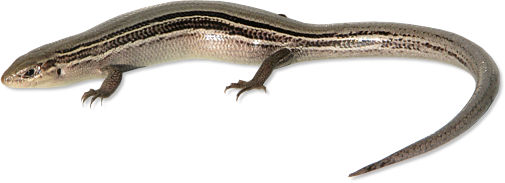
Biology of the Northern Prairie Skink
(Plestiodon septentrionalis)
| By Errol J. Bredin | (Click links for more images.) |
Description
The Northern Prairie Skink is a smooth, shiny, alert lizard that, if seen, can prove very difficult to catch. Adults range in length from 127 mm to 204 mm (5 to 8 inches), with older ones not necessarily being the larger. With reptiles in general there appears to be extremes in retardation or acceleration of growth giving wide ranges in adult sizes.

The skink is a "many striped" lizard with a body pattern consisting of alternating stripes of light ashy olive, dark olive, and black lines. The belly can be a pale yellow, cream, or a faint bluish colour. Chin, throat, soles of the feet and sometimes a chest patch tend to be yellowish to pale yellow. The limbs are dark above and bluish-grey or yellowish underneath. A notable feature of young skinks is a brilliant blue tail, which dulls with age.
Classification
Here's the taxonomic classification of the northern prairie skink:
| Kingdom: Phylum: Class: Order: Suborder: Family: Genus: Species: |
Animalia Chordata Reptilia Squamata Lacertilia (lizards) Scincidae (the skinks) Plestiodon septentrionalis |
Name Derivation
 Scientific name: The scientific name for the northern prairie skink is Plestiodon septentrionalis (recently changed from Eumeces septentrionalis). Plestiodon is thought to derive from the Greek: "pleistos", meaning "most, the most or the greatest", "odontos" is from the Greek, meaning "teeth" (thanks to John White for helping out with the etymology). The species name "septentrionalis" is Latin for "of the north". So they are the "most-toothed skinks of the north".
Scientific name: The scientific name for the northern prairie skink is Plestiodon septentrionalis (recently changed from Eumeces septentrionalis). Plestiodon is thought to derive from the Greek: "pleistos", meaning "most, the most or the greatest", "odontos" is from the Greek, meaning "teeth" (thanks to John White for helping out with the etymology). The species name "septentrionalis" is Latin for "of the north". So they are the "most-toothed skinks of the north".
Common Name: The name, northern prairie skink is pretty logical in that this is a skink of the northern prairies of North America. Not so obvious is the origin of the word "skink". Anybody out there have a clue?
Distribution
The Northern Prairie Skink is Manitoba's only lizard and outside of some 177,000 hectares of Carberry Sandhills habitat, it is found nowhere else in Canada. The skink migrated into Manitoba many thousands of years ago from the south. Today, the northern apex of the continuous range of this species reaches the extreme southeastern corner of North Dakota and central Minnesota, some 500 km south of the Manitoba population.
North American
distribution of E. septentrionalis
- after Conant and Collins 1998.
|
At its height, glacial Lake Agassiz covered much of Manitoba and tapered south into North Dakota and Minnesota terminating in the vicinity of the extreme southeastern corner of North Dakota. As this immense lake receded and the climate moderated it is believed that the skink moved northward following the exposed beach lines of Lake Agassiz. It appears that this movement followed both east and west shorelines. Adjunct or isolated populations of skinks are found in two areas of northwestern Minnesota, the Agassiz Dunes Natural Area just southwest of Fertile, and farther north in a small tract of sandy dunes near Lake Bronson. Along the remnant western shoreline of Lake Agassiz there is an isolated occurrence of skinks just west of Fargo, North Dakota and some 300 km to the northeast, far removed from its relatives, the Northern Prairie Skink has found a home in the Carberry Sandhills. As climatic conditions changed, harsh winters soon eliminated skinks living on heavier soils where they could not burrow below frost lines. The ancient Assiniboine Delta provided these small nomads with a sandy security and today the Northern Prairie Skink is a truly unique member of Manitoba's reptile fauna.
The distribution of the Northern Prairie Skink in Manitoba is centered throughout Sprucewoods Provincial Park and the CFB Shilo military training range. From this central core, its distribution extends in a narrow finger between Carberry and Sidney to a point just south of Neepawa. Another narrow strip of suitable habitat runs eastward with skinks being sighted 15km north of Treherne. Diminished numbers of skinks extend south to the Glenboro area. The primary factor in the distribution of the skink is soil type. They occur almost exclusively on what is termed Stockton Loamy Sands, these are the sands that comprise the Assiniboine Delta.
Life Cycle
With the advent of spring, and soon after the lavender tinge of blooming Prairie Crocus has left the ridges, skinks begin to emerge from hibernation. Weather plays a definite roll, and dates vary from year to year, but emergence usually takes place in late April to early May. This year (1999) is the earliest I have sighted active skinks, the date was April 22nd. Indications are that males tend to emerge first, and soon after their jaws and throat begin to turn a distinctive, bright orange. When this temporary coloration is at its height the breeding season begins, and it continues from mid-May to early June.
Skinks will breed in captivity, as I found by placing pairs in a terrarium that had been prepared to be as close to their natural surroundings as possible. When the male begins to show interest in the female he arches his tail upward with the tip dragging on the ground. He will then begin to pursue the female, nudging her gently and lightly biting her torso. This continues for ten to fifteen minutes. Finally, he grasps the skin above her front legs firmly in his jaws, encircles her and copulation occurs, lasting a minute or two.
The breeding season affords the best opportunity to observe skinks, as this is when they are most active. As the breeding season ends, both males and females tend to become extremely secretive, with both sexes spending greater amounts of time under some form of surface cover. Males quickly lose their distinctive orange coloration around the jaws, and determining the sex of a skink becomes very difficult.
After a gestation period of around forty days the female lays an average of eight eggs in a small nest cavity. These nests, as a rule, are under a piece of surface cover such as a log, piece of board, sheet of tin, etc. One nest I uncovered was under a discarded barrel lid with the eggs buried at a depth of 10 cm. in loose soil. The eggs look like extremely tiny chicken eggs, and when first laid are bright white and average 7 mm in width and 12 mm in length. The eggs have a thin, elastic, parchment-like shell that is easily punctured. During the incubation period the eggs absorb moisture and swell up considerably.
Skink nest uncovered, revealing clutch of eggs.
The female skink broods her clutch of eggs. After breeding a female in captivity I decided to keep her during gestation and egg laying as well as brooding, with the hope I might observe a successful hatch. Soon after gestation had begun she prepared a small nest cavity under a piece of board. Forty-one days after being last bred she laid a clutch of six eggs. Most of her time was then spent with the eggs, she rarely came out to bask in the sunshine (a favorite activity) or to feed. When the board was raised she could be observed lying with her body coiled around the eggs. If the eggs were moved outside the nest she would immediately begin replacing them by rolling or pushing them with her nose or a loop of her tail. Several times I observed her moving the eggs about in the nest cavity herself. Studies have shown that female skinks seem to sense subtle changes in humidity levels and will move their eggs in response to those changes. Thirty-six days after being laid a single egg hatched and the young skink and its mother were returned to the place where I had captured the female.
As soon as the eggs begin to hatch in the wild, or shortly after, the female will leave the nest. Within a few days the young begin to disperse from the nest and forage for food. Hatchlings are very dark upon emergence from the egg and average around 58 mm to 62 mm in length. They are highly active. I've often observed them darting around with their bright blue tails arched aloft. The earliest date I've found hatchlings in the wild is August 4th . One hatchling, last sighted on September 9th , when measured, revealed a growth rate approaching 1 mm per day. These young skinks reach sexual maturity after emergence from their second hibernation.
Carry on for Even More Biology of Skinks!![]()
| You can help NatureNorth produce more great articles with a secure donation through PayPal. Our Google Adsense ads pay our server costs, but that's about it. To learn more follow this link: Support NatureNorth. Thank-you! | |
Return to: Summer Issue | NatureNorth Front page

